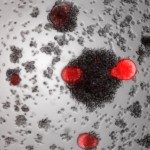Link to Pubmed [PMID] – 12358433
RNA 2002 Sep;8(9):1137-47
There are two major components of Escherichia coli ribosomes directly involved in selection and binding of mRNA during initiation of protein synthesis-the highly conserved 3′ end of 16S rRNA (aSD) complementary to the Shine-Dalgarno (SD) domain of mRNA, and the ribosomal protein S1. A contribution of the SD-aSD and S1-mRNA interactions to translation yield in vivo has been evaluated in a genetic system developed to compare efficiencies of various ribosome-binding sites (RBS) in driving beta-galactosidase synthesis from the single-copy (chromosomal) lacZ gene. The in vivo experiments have been supplemented by in vitro toeprinting and gel-mobility shift assays. A shortening of a potential SD-aSD duplex from 10 to 8 and to 6 bp increased the beta-galactosidase yield (four- and sixfold, respectively) suggesting that an extended SD-aSD duplex adversely affects translation, most likely due to its redundant stability causing ribosome stalling at the initiation step. Translation yields were significantly increased upon insertion of the A/U-rich S1 binding targets upstream of the SD region, but the longest SD remained relatively less efficient. In contrast to complete 30S ribosomes, the S1-depleted 30S particles have been able to form an extended SD-aSD duplex, but not the true ternary initiation complex. Taken together, the in vivo and in vitro data allow us to conclude that S1 plays two roles in translation initiation: It forms an essential part of the mRNA-binding track even when mRNA bears a long SD sequence, and through the binding to the 5′ untranslated region, it can ensure a substantial enhancing effect on translation.

